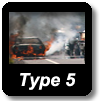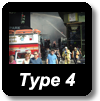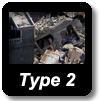
|
 |
Type 5 incidents would commonly include vehicle fires, motor
vehicle accidents, typical structure fires, dumpster fires and in some cases
fire alarm activations.
- The
incident can be handled with one or two single resources with up to six
personnel.
- Command and General Staff positions (other than the Incident Commander)
are not activated.
- No written Incident Action Plan (IAP) is required.
- The incident is contained within the first operational period and often
within an hour to a few hours after resources arrive on the scene.
|
Examples include a vehicle fire,
an injured person, or a police traffic stop. |

|
 | Type 4 incidents would typically include a major structure
fire, a multiple vehicle crash with multiple patients, or a hazmat spill.
- Command and General Staff functions are activated only if needed.
- Several resources are required to mitigate the incident, possibly including
Task Forces or Strike Teams.
- The incident is usually limited to one operational period in the control
phase, usually in a few hours after resources arrive on scene.
- The agency administrator may have briefings, and ensure the complexity
analysis and delegation of authority are updated.
- No written Incident Action Plan (IAP) is required but a documented
operational briefing will be completed for all incoming resources.
|
Examples include a building fire or large protest/rally. |

|
 |
Type 3 incidents include those where capabilities exceed
initial attack and the appropriate ICS positions should be added to match
the complexity of the incident. Examples include a tornado touchdown,
earthquake, flood, or multi-day incident. When capabilities exceed initial
emergency response, the appropriate ICS positions should be added to match
the complexity of the incident.
- Some or all of the Command and General
Staff positions may be activated, as well as Division/Group supervisor
and/or Unit Leader level positions
- A Type 3 Incident Management Team (IMT) or incident command organization
manages initial action incidents with a significant number of resources, an
extended attack incident until containment/control is achieved, or an
expanding incident until transition to a Type 1 or 2 team.
- The incident may extend into multiple operational periods.
- A written IAP may be required for each operational period.
|
Examples include a chemical leak with evacuation, tropical
storm/hurricane or a hostage stand-off.
|

|
 |
Type 2 incidents include the type of incident that extends
beyond the capabilities for local control and is expected to go into
multiple operational periods. A Type 2 Incident may require the response of
resources out of area, including regional and/or national resources, to
effectively manage the operations, command and general staffing. These
incidents typically involve incidents of regional significance.
- Most or all of the Command and General Staff positions are filled.
- A written IAP is required for each operational period.
- Many of the functional units are needed and staffed.
- Operations personnel normally do not exceed 200 per operational period and
total incident personnel do not exceed 500 (guidelines only)
- The agency administrator is responsible for the incident complexity
analysis, agency administrator briefings, and the written delegation of
authority
|
Examples include a devastating flood or earthquake.
|

|
 |
Type 1 Incidents are the most complex, requiring national
resources to safely and effectively manage and operate. These incidents are
of significance to the country and are managed by a nationally qualified
team.
- All Command and General Staff positions are activated
- Operations personnel often exceed 500 per operational period and total
incident personnel will usually exceed 51,000.
- Branches need to be established.
- The agency administrator will have briefings, and ensure that the
complexity analysis and delegation of authority are updated.
- Use of resource advisors at the incident base is recommended.
- There is a high impact on the local jurisdiction, requiring additional
staff for office administrative and support functions.
|
Examples include a major terrorist attack, or a Katrina, Japan, Haiti
level disaster.
|

|